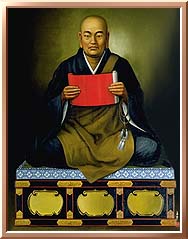|

Born as a fisherman's son, he was called Zennichimaro. He went to Seicho-ji temple, in his home province of Awa to study Buddhism
in 1233. Shortly after his tonsure at sixteen, he took the name of Rencho and went to Kamakura for further studies. After
returning from Kamakura, he traveled to Kyoto and Nara, the old centers of traditional Buddhism in Japan, where he mastered
all the sutras and literature of Buddhism. In 1253, returning to Seicho-ji, Rencho adopted the name Nichiren (Sun-Lotus) when
he advocated chanting "Nam-myoho-renge-kyo" for the first time. He declared the establishment of a new Buddhism.
In 1279 he inscribed the Dai-Gohonzon as the fundamental object of respect for the peace and happiness of all mankind. He
died three years later.
The term "Daishonin" is an honorific title meaning "great sage" and
has been traditionally used in reference to Nichiren, e.g. Nichiren Daishonin, by the Nichiren Shoshu school of Buddhism.
The Soka Gakkai and SGI have adopted this usage in most publications; however it is not commonly used in society or by academic
and religious scholars.
The revolutionary nature of Nichiren's achievement lies in the fact that he made it possible,
for the first time, for all people to actually practice the highest teachings of Buddhism by providing a methodology whereby
they can establish a life-condition of absolute happiness, unswayed by changing outer circumstances.
|